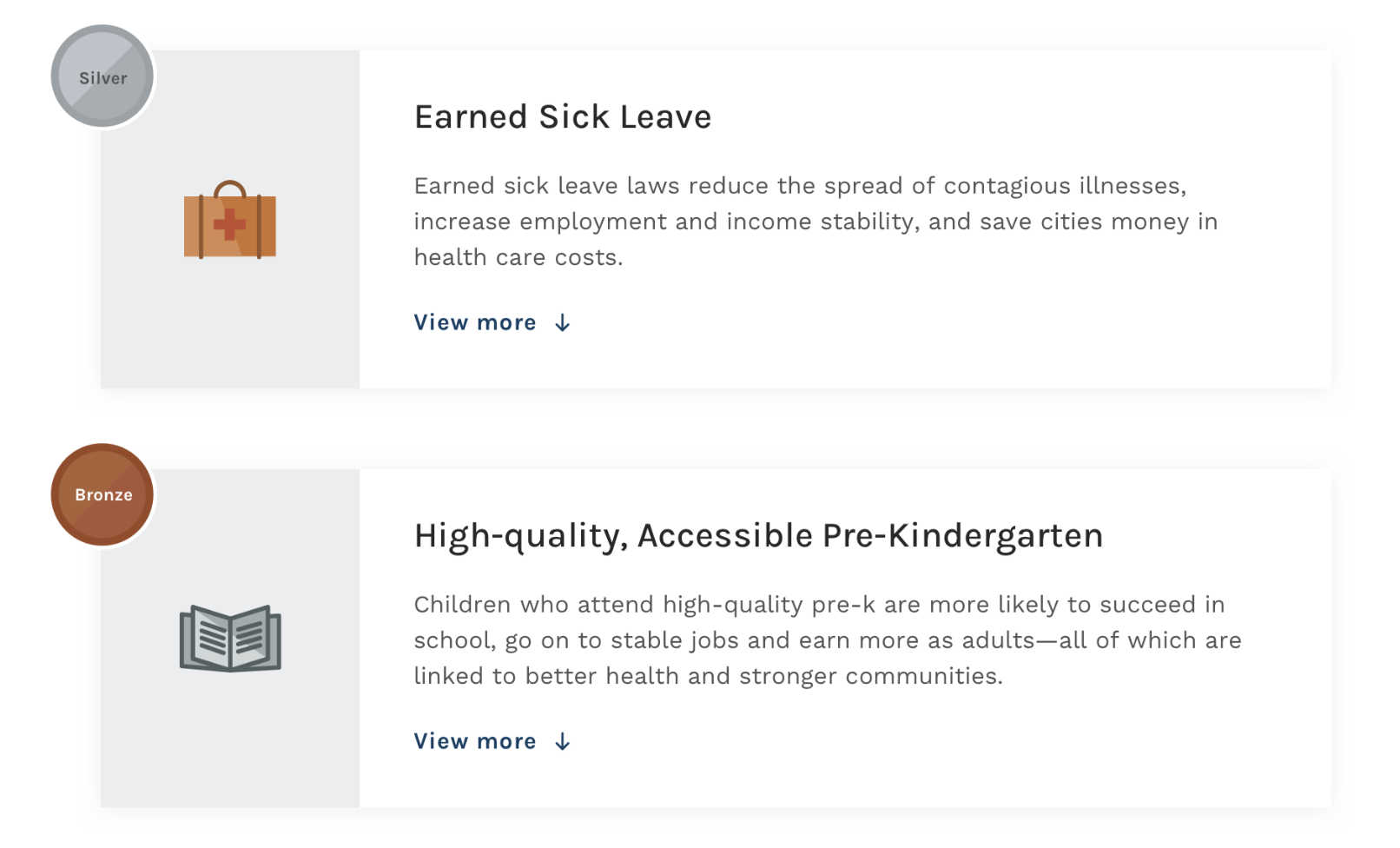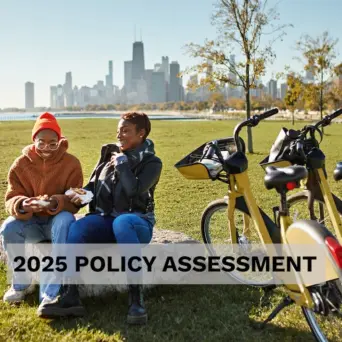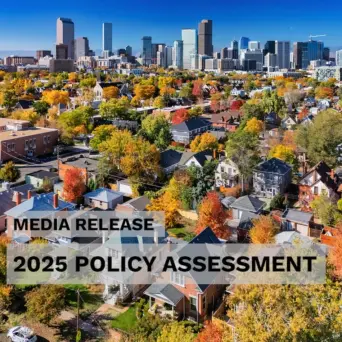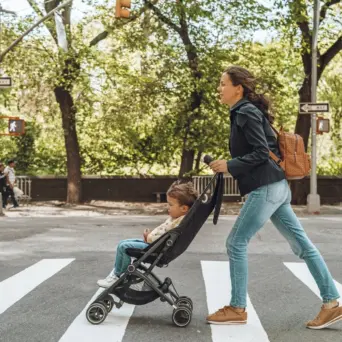Policy Overview

Affordable Housing Trusts
Affordable Housing Trusts policies are a community-driven way for cities to invest in building and maintaining affordable housing for everyone.
View more
Policy Criteria
LEGEND

Criteria met to earn a medal

Criteria met but not enough to earn a medal

Criteria not met to earn a medal
Criteria required to earn Gold medal
Criteria required to earn Silver medal
Criteria required to earn Bronze medal
Policy Criteria



City has established an affordable housing trust fund.

City policy includes a multi-stakeholder oversight board.

City policy identifies or establishes a dedicated revenue source to fund the trust.

City policy identifies or establishes a dedicated, recurring revenue source to fund the trust.

City policy references affordability levels.

City policy requires regular evaluation and public reporting on how trust funds have been spent.

LEGEND

Criteria met to earn a medal
Criteria required to earn Gold medal

Criteria met but not enough to earn a medal
Criteria required to earn Silver medal

Criteria not met to earn a medal
Criteria required to earn Bronze medal
*Data valid from 01/07/2025 through 06/01/2025

Complete Streets
Complete streets policies unlock opportunities by allowing city residents to safely walk, bike, drive and take public transit around their community.
View more
Policy Criteria
LEGEND

Criteria met to earn a medal

Criteria met but not enough to earn a medal

Criteria not met to earn a medal
Criteria required to earn Gold medal
Criteria required to earn Silver medal
Criteria required to earn Bronze medal
Policy Criteria



City has a complete streets policy

Policy requires compliance.

Policy balances pedestrians, bicyclists, and at least two other modes.

Policy references the adoption of specific design guidelines, and/or requires the development or revision of internal design policies and guides.

Policy explicitly prioritizes vulnerable users.

Policy requires compliance of all new construction and reconstruction or retrofit projects.

Policy references compliance of all maintenance projects and ongoing operations.

Policy assigns a department to oversee implementation.

Policy references the development of an inclusive community engagement plan.

Policy requires the collection and publication of performance measures, including performance measures that account for equity.

Policy includes explicit exemptions.

Policy encourages private development projects comply.

Policy establishes a timeline for the review and improvements to project selection criteria.

LEGEND

Criteria met to earn a medal
Criteria required to earn Gold medal

Criteria met but not enough to earn a medal
Criteria required to earn Silver medal

Criteria not met to earn a medal
Criteria required to earn Bronze medal
*Data valid from 01/01/2025 through 06/01/2025

Earned Sick Leave
When we’re sick or injured, we need paid time off from work to rest and heal. Cities that require companies to offer Earned Sick Leave ensure that all employees feel secure in their jobs when they fall ill — and keep communities healthy by stopping the spread of contagious illness.
View more
Policy Criteria
LEGEND

Criteria met to earn a medal

Criteria met but not enough to earn a medal

Criteria not met to earn a medal
Criteria required to earn Gold medal
Criteria required to earn Silver medal
Criteria required to earn Bronze medal
Policy Criteria



City has an earned sick leave law

Employee can use earned sick leave to care for family members

Employee can use earned sick leave for domestic violence recovery

Minimum amount of earned sick leave time employee can earn

Smallest business size covered under earned sick leave law

LEGEND

Criteria met to earn a medal
Criteria required to earn Gold medal

Criteria met but not enough to earn a medal
Criteria required to earn Silver medal

Criteria not met to earn a medal
Criteria required to earn Bronze medal
*Data valid from 01/01/2025 through 06/01/2025

Eco-Friendly Purchasing
Toxic chemicals that damage our health can be found in everything from cleaning products to carpets. City leaders can lead by example and lessen exposure for city workers, residents, and visitors by buying products free of toxic chemicals.
View more
Policy Criteria
LEGEND

Criteria met to earn a medal

Criteria met but not enough to earn a medal

Criteria not met to earn a medal
Criteria required to earn Gold medal
Criteria required to earn Silver medal
Criteria required to earn Bronze medal
Policy Criteria



The city has an eco-friendly purchasing policy that requires annual reporting.

The city has an eco-friendly purchasing policy that meets independent standards for at least one of the following high-priority categories: furnishings, foodware, cleaning products.

The city’s eco-friendly purchasing policy applies to all requests for proposals (RFPs) and contracts.

LEGEND

Criteria met to earn a medal
Criteria required to earn Gold medal

Criteria met but not enough to earn a medal
Criteria required to earn Silver medal

Criteria not met to earn a medal
Criteria required to earn Bronze medal
*Data valid from 04/01/2022 through 06/01/2025

Flavored Tobacco Restrictions
Flavored tobacco products — including flavored e-cigarettes and menthol cigarettes — endanger the health of our communities. The tobacco industry uses flavored tobacco products to lure new users, especially young people, into tobacco addiction.
View more
Policy Criteria
LEGEND

Criteria met to earn a medal

Criteria met but not enough to earn a medal

Criteria not met to earn a medal
Criteria required to earn Gold medal
Criteria required to earn Silver medal
Criteria required to earn Bronze medal
Policy Criteria



City has a flavored tobacco law that prohibits the sale, by all retailers, of at least one category of flavored tobacco products.

The law does not contain any penalties for youth use, purchase, or possession.

City has a flavored tobacco law that prohibits the sale, by all retailers, of at least two categories of flavored tobacco products.

City has a flavored tobacco law, which prohibits the sale, by all retailers, of all flavored tobacco products, with no exceptions.

LEGEND

Criteria met to earn a medal
Criteria required to earn Gold medal

Criteria met but not enough to earn a medal
Criteria required to earn Silver medal

Criteria not met to earn a medal
Criteria required to earn Bronze medal
*Data valid from 01/01/2025 through 06/01/2025

Greenspace
Public greenspaces, from parks to trails to public commons, help families be healthier in body and mind and keep our environment thriving. Greenspace policies ensure all families, not just a few, have access to public land, nature, and their benefits.
View more
Policy Criteria
LEGEND

Criteria met to earn a medal

Criteria met but not enough to earn a medal

Criteria not met to earn a medal
Criteria required to earn Gold medal
Criteria required to earn Silver medal
Criteria required to earn Bronze medal
Policy Criteria



The city council has adopted or ratified a policy or formalized planning goal either to a) achieve 100% park access within a 10-minute walk for all residents by 2040 or b) increase tree canopy coverage, with a specific measurable goal and time frame.

The city’s public spending on parks and greenspace is at or above the national median per capita, and the city maintains that level of spending within $10.*

Either the city’s 10-minute walk policy or its tree canopy goal clearly prioritizes underserved and disinvested neighborhoods, based on racial and/or economic equity, and/or data-driven park need.

*The public funding data used for the Greenspace medals do not include programmatic investments. These measures are adjusted for local cost of living and inflation. These funding data are derived from the annual City Park Facts survey conducted by the Trust for Public Land.
LEGEND

Criteria met to earn a medal
Criteria required to earn Gold medal

Criteria met but not enough to earn a medal
Criteria required to earn Silver medal

Criteria not met to earn a medal
Criteria required to earn Bronze medal
*Data valid through 09/05/2025

Healthy Food Purchasing
When cities have healthy food available on public property, we all have more opportunity to choose what’s best for our bodies. Cities that prioritize health in their food purchases make sure everyone has access to healthy choices in public places where we work, play, and learn.
View more
Policy Criteria
LEGEND

Criteria met to earn a medal

Criteria met but not enough to earn a medal

Criteria not met to earn a medal
Criteria required to earn Gold medal
Criteria required to earn Silver medal
Criteria required to earn Bronze medal
Policy Criteria



City has a procurement policy mandating nutrition standards.

City procurement policy applies to one or more venues where food is sold or served on city property or by a city agency or city contractor. The policy may apply only to vending machines.

City has a procurement policy mandating nutrition standards at least as strong as the Foodservice Guidelines for Federal Facilities.

City procurement policy applies to EITHER:
• All venues where food is sold on city property
OR
• All venues where food is purchased with city funds and/or served by city agencies, contractors, or subcontractors.

City has a procurement policy mandating nutrition standards at least as strong as the Foodservice Guidelines for Federal Facilities (innovative level).

Policy applies to all venues where food is sold or served on city property or by city agencies, contractors, or subcontractors, or purchased with city funds.

LEGEND

Criteria met to earn a medal
Criteria required to earn Gold medal

Criteria met but not enough to earn a medal
Criteria required to earn Silver medal

Criteria not met to earn a medal
Criteria required to earn Bronze medal
*Data valid from 09/01/2011 through 06/01/2025

Healthy Rental Housing
Healthy Rental Housing policies ensure that homes in our communities meet the safety standards we all want — from good plumbing to lead-free paint. Proactive rental inspections can help detect life-threatening toxins, like mold and asbestos.
View more
Policy Criteria
LEGEND

Criteria met to earn a medal

Criteria met but not enough to earn a medal

Criteria not met to earn a medal
Criteria required to earn Gold medal
Criteria required to earn Silver medal
Criteria required to earn Bronze medal
Policy Criteria



City has a policy that requires at least bi-annual (once every two years) rental registration of buildings with three or more units for all property types. Certain exemptions may be allowed including, but not limited to, when the unit is vacant, a family member is living there but not on the deed, units where rent is not collected, and if the owner occupies one of the units.

City policy requires routine, periodic inspections to be conducted at least every 10 years.

City policy requires inspection of the property exterior.

City policy requires advanced notice of inspection to go to the landlord or the tenant.

City policy requires routine, periodic inspections to be conducted at least every five years.

City policy requires inspection of property exteriors and interiors when there is an exterior violation.

City policy requires landlords to pay registration or inspection fees.

City policy requires an evaluation or reporting requirement.

LEGEND

Criteria met to earn a medal
Criteria required to earn Gold medal

Criteria met but not enough to earn a medal
Criteria required to earn Silver medal

Criteria not met to earn a medal
Criteria required to earn Bronze medal
*Data valid from 06/27/2013 through 06/01/2025

High-Quality, Accessible Pre-K
Early childhood education is an essential step to access real opportunities later in life — from successfully graduating high school to staying healthy. It also provides parents a safe place for kids to learn, play, and grow.
View more
Policy Criteria
LEGEND

Criteria met to earn a medal

Criteria met but not enough to earn a medal

Criteria not met to earn a medal
Criteria required to earn Gold medal
Criteria required to earn Silver medal
Criteria required to earn Bronze medal
Policy Criteria



Policy meets 2 out of 3 criteria* (access, local funding, and equity data) and meets at least 4 quality benchmarks

Policy meets 8 out of 10 NIEER quality benchmarks

Policy meets 9 out of 10 NIEER quality benchmarks

*Criteria include:
- Access: Establishes a 30% access threshold for pre-K programs. Quality learning can only make an impact if children have access to the programming.
- Equity: City collects demographic data that allows local leaders and residents see who in their community is receiving services.
- Local Funding: Local funding is included in a city’s pre-K program. Pre-K programs with a local funding source often mean that cities have a stake in the quality, access, and equitable delivery of their pre-K programs.
LEGEND

Criteria met to earn a medal
Criteria required to earn Gold medal

Criteria met but not enough to earn a medal
Criteria required to earn Silver medal

Criteria not met to earn a medal
Criteria required to earn Bronze medal
*Data valid from 10/10/2025 through 10/10/2025

Legal Support for Renters
Renters have legal protections, but few can access those protections when faced with eviction because most don’t have the means to obtain legal representation.
View more
Policy Criteria
LEGEND

Criteria met to earn a medal

Criteria met but not enough to earn a medal

Criteria not met to earn a medal
Criteria required to earn Gold medal
Criteria required to earn Silver medal
Criteria required to earn Bronze medal
Policy Criteria



City has a legal support policy that provides full legal representation for all eligible tenants.*

Policy includes limited coverage.**

Policy includes both limited coverage and enhanced coverage.***

Policy requires evaluation.

Policy requires evaluation and reporting.

LEGEND

Criteria met to earn a medal
Criteria required to earn Gold medal

Criteria met but not enough to earn a medal
Criteria required to earn Silver medal

Criteria not met to earn a medal
Criteria required to earn Bronze medal
*Data valid from 07/01/2022 through 06/01/2025

Safer Alcohol Sales
Where and how alcohol is sold plays an important role in family safety. Neighborhoods that have fewer alcohol stores experience significantly less crime. When communities have smart policies and practices around alcohol sales, we keep everyone safer.
View more
Policy Criteria
LEGEND

Criteria met to earn a medal

Criteria met but not enough to earn a medal

Criteria not met to earn a medal
Criteria required to earn Gold medal
Criteria required to earn Silver medal
Criteria required to earn Bronze medal
Policy Criteria



City has a law that applies to all alcohol sales, addresses public health and safety, and authorizes the city to close an alcohol retailer for failing to comply with the law.
City has a law that applies to some alcohol sales (such as only new retailers, or only retailers selling for off-premises consumption including grocery or convenience stores), addresses public health and safety, and authorizes the city to close an alcohol retailer for failing to comply with the law.

LEGEND

Criteria met to earn a medal
Criteria required to earn Gold medal

Criteria met but not enough to earn a medal
Criteria required to earn Silver medal

Criteria not met to earn a medal
Criteria required to earn Bronze medal
*Data valid from 08/30/2025 through 08/30/2025

Smoke Free Indoor Air
We all know the harmful effects that secondhand smoke and vapor can have. Casinos, gaming venues, multi-unit housing, and bars — or any other public space we enjoy with family and friends — should have clean air to protect everyone’s health.
View more
Policy Criteria
LEGEND

Criteria met to earn a medal

Criteria met but not enough to earn a medal

Criteria not met to earn a medal
Criteria required to earn Gold medal
Criteria required to earn Silver medal
Criteria required to earn Bronze medal
Policy Criteria



Smoking is prohibited in non-hospitality workplaces, including nursing home facilities common spaces and childcare facilities; in restaurants and bars; and in public places.

Smoking or vaping tobacco, including e-cigarettes and other heated tobacco products, is banned in non-hospitality workplaces, including nursing home facilities common spaces and childcare facilities; in restaurants and bars; and in public places.

Ban includes one of the following: casinos and gaming industry venues; multi-unit housing containing more than three units; marijuana; or private rooms in nursing home facilities.

LEGEND

Criteria met to earn a medal
Criteria required to earn Gold medal

Criteria met but not enough to earn a medal
Criteria required to earn Silver medal

Criteria not met to earn a medal
Criteria required to earn Bronze medal
*Data valid from 01/01/2024 through 06/01/2025






